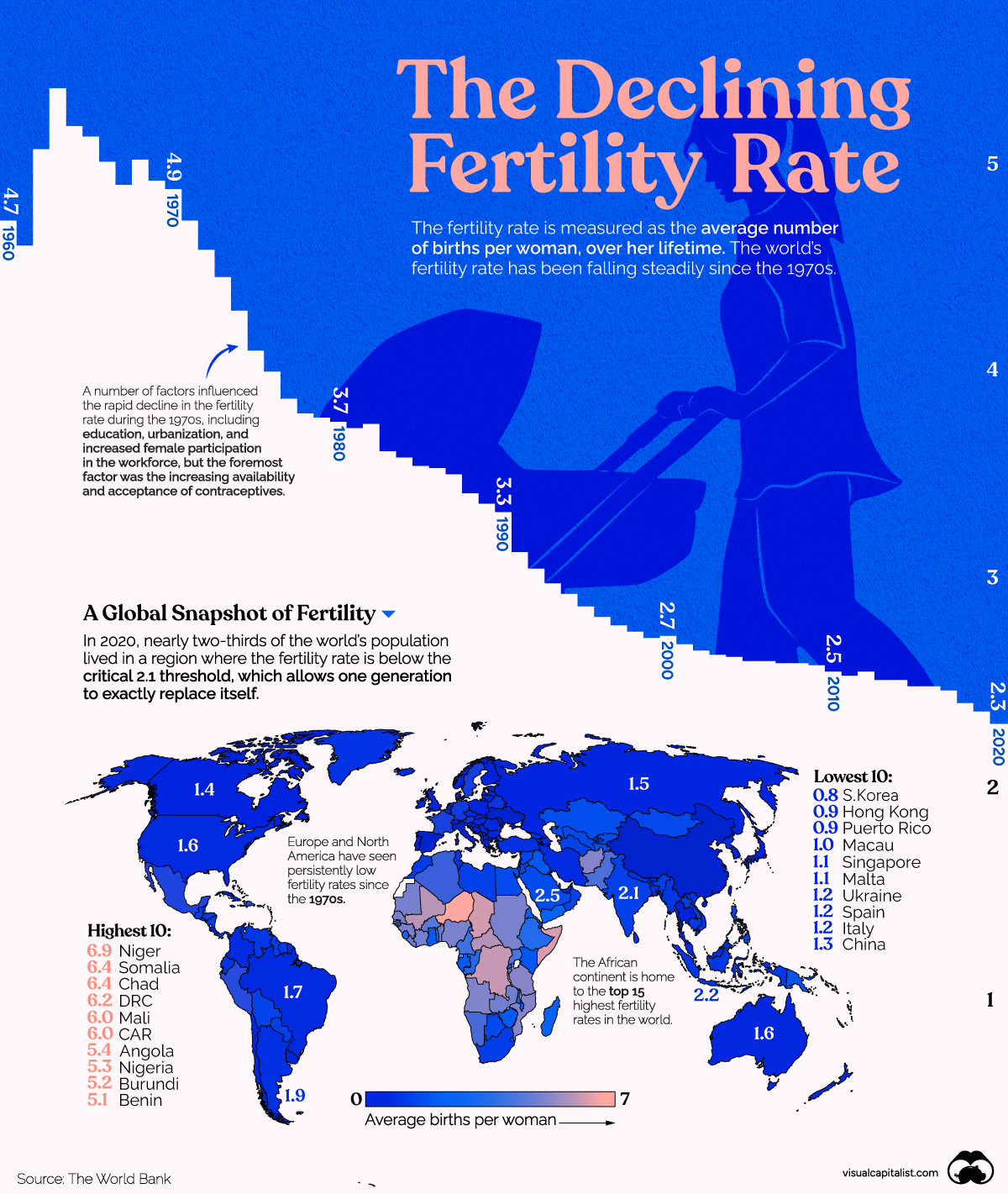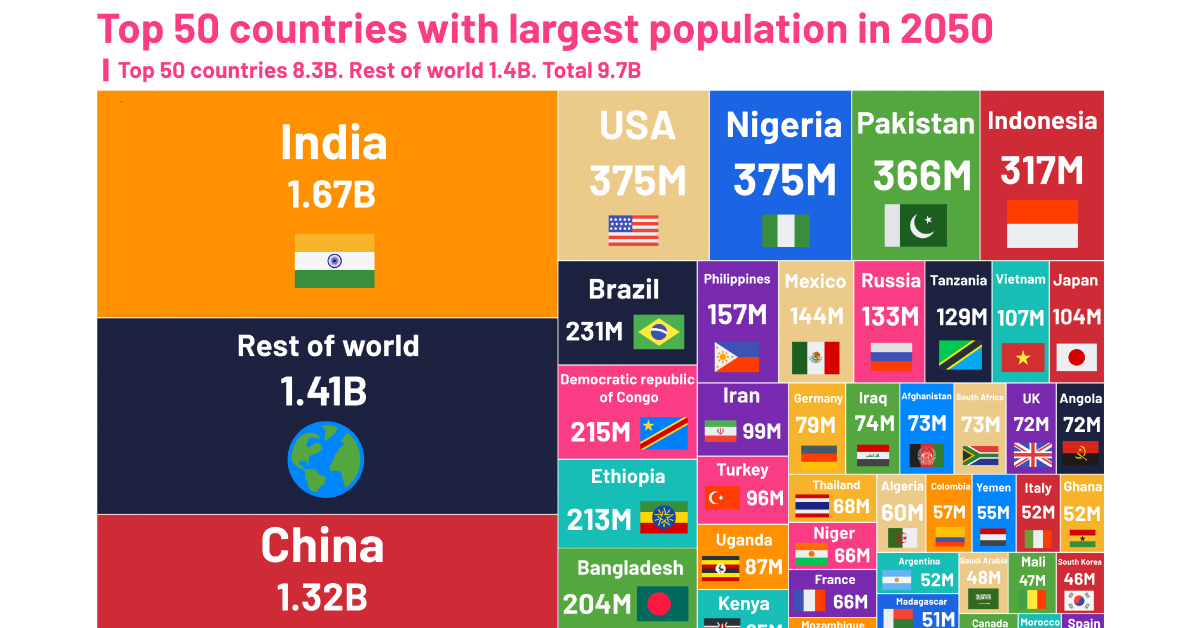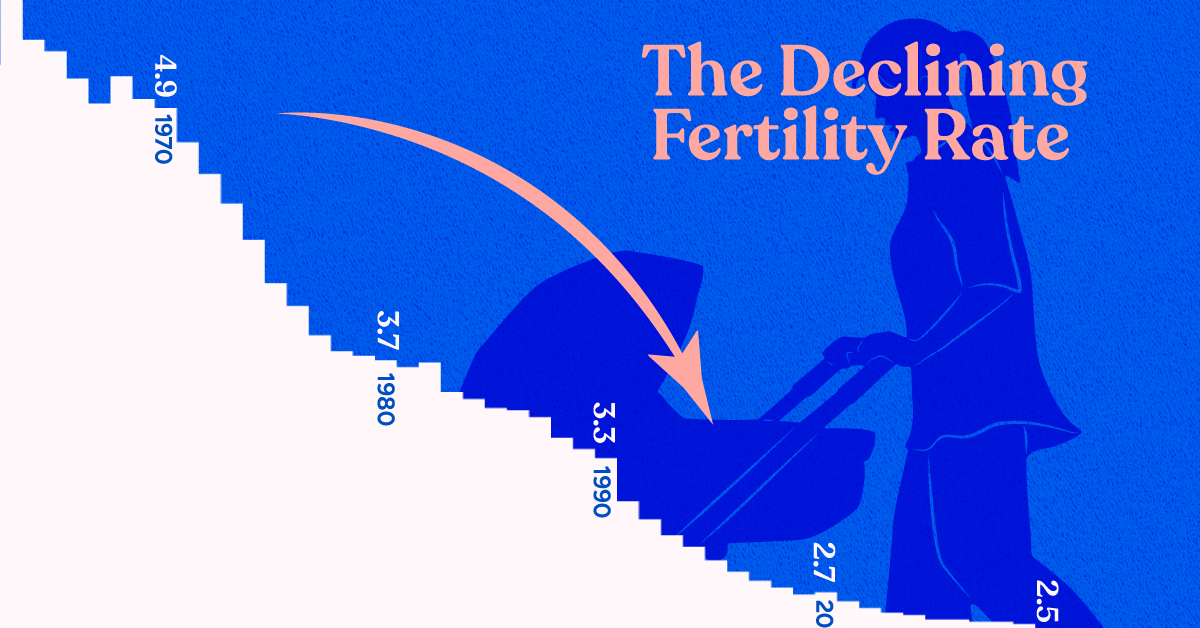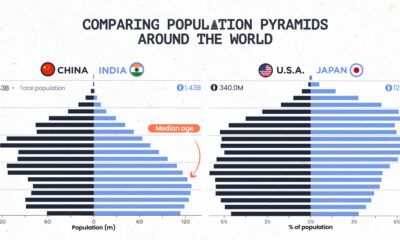population
Visualizing the World’s Plummeting Fertility Rate

Visualizing the World’s Plummeting Fertility Rate
At the dawn of the 19th century, the world population hit a big milestone: 1 billion people.
Over the next 220 years, the number grew to eight times that, or the 8 billion people who live on the planet today, with half of the growth occurring since 1975.
This continuous climb in global population has been possible thanks to advancements in healthcare and nutrition. However, the UN forecasts that rapid growth will slow down—and may even stop entirely by 2100—because of falling fertility rates.
What does that mean for modern nation states conditioned to expect a constant influx of new citizens and labor to power their economies? And how can those changing economies adapt to a shrinking population?
To understand that, we need to first untangle fertility rates, and why they’re falling.
Explained: Fertility and Replacement Rates
The total fertility rate is the average number of births per woman over a lifetime. This measurement makes two key assumptions, however:
- The woman will live to the end of her childbearing years
- The woman will bear children according to the age-specific fertility rates currently observed
Both assumptions add some uncertainty to future fertility rate projections. However, decades of past data collected by the World Bank help show some overall trends around the world, and in many countries.
The world fertility rate (expressed as the number of children per woman) has been falling steadily since the 1970s.
In 2020, the world’s fertility rate stood at 2.3, slightly above the replacement rate of 2.1 births per woman, which allows for one generation to replace itself. This is down more than two times from 4.7 in 1960.
But the world’s average hides the vast disparities between the fertility rate of countries. We dive into the differences below.
Which Country has the Highest Fertility Rate?
According to the UN, nearly two-thirds of the world’s population lives in a region where the fertility rate is below the critical 2.1 threshold. In the table below, countries are ranked from the highest to lowest average births per woman in 2020.
| Rank | Country Name | 1960 | 1975 | 1990 | 2005 | 2020 |
|---|---|---|---|---|---|---|
| 1 | Niger | 7.53 | 7.54 | 7.81 | 7.62 | 6.89 |
| 2 | Somalia | 7.25 | 7.03 | 7.44 | 7.48 | 6.42 |
| 3 | Chad | 6.25 | 6.88 | 7.22 | 7.13 | 6.35 |
| 4 | Dem. Rep. of Congo | 6.08 | 6.42 | 6.70 | 6.60 | 6.21 |
| 5 | Mali | 7.00 | 7.24 | 7.25 | 6.72 | 6.04 |
| 6 | Central African Republic | 5.81 | 5.89 | 6.05 | 5.85 | 5.99 |
| 7 | Angola | 6.71 | 7.49 | 7.27 | 6.46 | 5.37 |
| 8 | Nigeria | 6.36 | 6.77 | 6.46 | 6.07 | 5.31 |
| 9 | Burundi | 7.00 | 7.24 | 7.37 | 6.71 | 5.18 |
| 10 | Benin | 6.28 | 6.85 | 6.73 | 5.68 | 5.05 |
| 11 | Burkina Faso | 6.25 | 6.91 | 7.01 | 6.18 | 4.87 |
| 12 | Tanzania | 6.73 | 7.00 | 6.20 | 5.61 | 4.80 |
| 13 | Gambia | 6.25 | 6.41 | 6.22 | 5.72 | 4.78 |
| 14 | Afghanistan | 7.28 | 7.54 | 7.57 | 6.91 | 4.75 |
| 15 | Mozambique | 6.32 | 6.69 | 6.22 | 5.61 | 4.71 |
| 16 | Uganda | 6.94 | 7.23 | 7.04 | 6.57 | 4.69 |
| 17 | Cameroon | 5.65 | 6.39 | 6.39 | 5.41 | 4.54 |
| 18 | South Sudan | 6.72 | 6.92 | 7.99 | 6.17 | 4.54 |
| 19 | Sudan | 6.65 | 6.93 | 6.17 | 5.04 | 4.54 |
| 20 | Guinea | 6.11 | 6.37 | 6.63 | 5.70 | 4.49 |
| 21 | Cote d'Ivoire | 7.69 | 7.91 | 6.73 | 5.46 | 4.47 |
| 22 | Mauritania | 6.35 | 6.68 | 6.06 | 5.19 | 4.46 |
| 23 | Senegal | 7.00 | 7.25 | 6.40 | 5.19 | 4.45 |
| 24 | Zambia | 7.12 | 7.39 | 6.53 | 5.71 | 4.38 |
| 25 | Equatorial Guinea | 5.65 | 5.79 | 5.99 | 5.56 | 4.35 |
| 26 | Togo | 6.72 | 7.15 | 6.13 | 5.07 | 4.32 |
| 27 | Ethiopia | 6.88 | 7.14 | 7.24 | 5.97 | 4.24 |
| 28 | Rep. of Congo | 6.09 | 6.36 | 5.21 | 4.66 | 4.23 |
| 29 | Liberia | 6.39 | 6.74 | 6.37 | 5.52 | 4.17 |
| 30 | Guinea-Bissau | 5.92 | 6.15 | 6.51 | 5.45 | 4.09 |
| 31 | Sierra Leone | 6.18 | 6.55 | 6.57 | 5.81 | 4.08 |
| 32 | Comoros | 6.79 | 7.12 | 6.50 | 5.03 | 4.05 |
| 33 | Solomon Islands | 6.97 | 7.07 | 5.66 | 4.48 | 4.04 |
| 34 | Samoa | 7.65 | 6.68 | 4.93 | 4.37 | 4.00 |
| 35 | Malawi | 7.03 | 7.40 | 6.81 | 5.91 | 4.00 |
| 36 | Eritrea | 6.48 | 6.59 | 6.34 | 4.93 | 3.93 |
| 37 | Madagascar | 7.30 | 7.10 | 6.16 | 5.10 | 3.92 |
| 38 | Sao Tome & Principe | 6.24 | 6.53 | 5.83 | 4.96 | 3.89 |
| 39 | Yemen | 7.94 | 8.40 | 8.61 | 5.58 | 3.89 |
| 40 | Rwanda | 8.19 | 8.22 | 6.87 | 5.44 | 3.87 |
| 41 | Vanuatu | 6.86 | 6.09 | 5.03 | 4.16 | 3.78 |
| 42 | Ghana | 6.85 | 6.77 | 5.71 | 4.54 | 3.62 |
| 43 | West Bank & Gaza | NA | NA | 6.78 | 4.84 | 3.57 |
| 44 | Pakistan | 6.80 | 6.81 | 6.36 | 4.64 | 3.56 |
| 45 | Iraq | 5.30 | 6.88 | 5.88 | 4.48 | 3.55 |
| 46 | Gabon | 4.42 | 5.39 | 5.46 | 4.21 | 3.55 |
| 47 | Zimbabwe | 7.22 | 6.98 | 4.87 | 3.67 | 3.55 |
| 48 | Kenya | 7.63 | 7.88 | 6.13 | 4.78 | 3.40 |
| 49 | Namibia | 6.21 | 6.54 | 5.32 | 3.56 | 3.35 |
| 50 | Kiribati | 6.55 | 5.03 | 4.64 | 3.80 | 3.33 |
| 51 | Papua New Guinea | 6.02 | 6.07 | 5.18 | 4.22 | 3.27 |
| 52 | Tonga | 6.89 | 5.43 | 4.64 | 4.18 | 3.27 |
| 53 | Timor-Leste | 6.32 | 5.19 | 5.81 | 5.71 | 3.25 |
| 54 | Tajikistan | 6.55 | 6.60 | 5.34 | 3.44 | 3.24 |
| 55 | Tuvalu | 4.78 | 3.50 | 3.91 | 3.63 | 3.19 |
| 56 | Kazakhstan | 4.53 | 3.39 | 2.72 | 2.22 | 3.13 |
| 57 | Lesotho | 5.82 | 5.90 | 4.76 | 3.44 | 3.05 |
| 58 | Kyrgyzstan | 5.38 | 4.66 | 3.63 | 2.50 | 3.00 |
| 59 | Egypt | 6.79 | 5.80 | 4.48 | 3.15 | 2.96 |
| 60 | Algeria | 7.50 | 7.37 | 4.56 | 2.56 | 2.94 |
| 61 | Israel | 3.87 | 3.55 | 2.82 | 2.84 | 2.90 |
| 62 | Mongolia | 6.83 | 7.13 | 4.23 | 2.03 | 2.90 |
| 63 | Uzbekistan | 6.61 | 5.89 | 4.07 | 2.36 | 2.90 |
| 64 | Eswatini | 6.75 | 6.75 | 5.25 | 3.68 | 2.89 |
| 65 | Jordan | 7.67 | 7.89 | 5.48 | 3.78 | 2.87 |
| 66 | Haiti | 6.21 | 5.69 | 5.48 | 3.83 | 2.87 |
| 67 | Djibouti | 6.83 | 6.77 | 5.98 | 3.99 | 2.85 |
| 68 | Botswana | 6.63 | 6.58 | 4.49 | 3.08 | 2.84 |
| 69 | Syria | 7.49 | 7.47 | 5.38 | 3.81 | 2.80 |
| 70 | Philippines | 7.15 | 5.60 | 4.35 | 3.49 | 2.78 |
| 71 | Micronesia | 6.69 | 6.68 | 4.96 | 3.60 | 2.75 |
| 72 | Turkmenistan | 6.59 | 5.90 | 4.24 | 2.66 | 2.70 |
| 73 | Oman | 7.25 | 7.75 | 6.61 | 3.05 | 2.69 |
| 74 | Bolivia | 6.36 | 5.79 | 4.89 | 3.56 | 2.65 |
| 75 | Guam | 5.91 | 3.91 | 3.05 | 2.76 | 2.59 |
| 76 | Lao | 6.29 | 6.29 | 6.08 | 3.67 | 2.54 |
| 77 | Libya | 7.37 | 7.96 | 4.97 | 2.77 | 2.51 |
| 78 | Paraguay | 6.50 | 5.21 | 4.55 | 3.04 | 2.50 |
| 79 | Fiji | 6.46 | 4.10 | 3.41 | 2.89 | 2.50 |
| 80 | Guatemala | 6.96 | 6.41 | 5.48 | 3.97 | 2.48 |
| 81 | Saudi Arabia | 7.63 | 7.37 | 5.83 | 3.24 | 2.47 |
| 82 | Guyana | 6.37 | 4.50 | 3.07 | 2.84 | 2.42 |
| 83 | South Africa | 6.16 | 5.19 | 3.72 | 2.51 | 2.40 |
| 84 | Honduras | 7.46 | 6.86 | 5.29 | 3.55 | 2.39 |
| 85 | Cambodia | 6.25 | 4.10 | 5.64 | 3.24 | 2.38 |
| 86 | Suriname | 6.61 | 4.73 | 3.27 | 2.75 | 2.37 |
| 87 | Morocco | 7.04 | 6.27 | 4.02 | 2.57 | 2.35 |
| 88 | Nicaragua | 7.16 | 6.50 | 4.60 | 2.77 | 2.35 |
| 89 | Panama | 5.84 | 4.42 | 3.10 | 2.67 | 2.34 |
| 90 | Dominican Republic | 7.56 | 5.24 | 3.41 | 2.61 | 2.30 |
| 91 | Faroe Islands | NA | 2.90 | 2.80 | 2.60 | 2.30 |
| 92 | World | 4.70 | 4.08 | 3.31 | 2.60 | 2.30 |
| 93 | Seychelles | NA | NA | NA | 2.20 | 2.29 |
| 94 | Venezuela, RB | 6.36 | 4.69 | 3.45 | 2.63 | 2.23 |
| 95 | Peru | 6.94 | 5.71 | 3.91 | 2.69 | 2.22 |
| 96 | Indonesia | 5.55 | 5.04 | 3.10 | 2.43 | 2.19 |
| 97 | Myanmar | 5.98 | 5.29 | 3.54 | 2.55 | 2.17 |
| 98 | Kuwait | 7.16 | 6.09 | 3.32 | 2.66 | 2.14 |
| 99 | Tunisia | 6.94 | 6.03 | 3.47 | 1.98 | 2.11 |
| 100 | Lebanon | 5.82 | 4.56 | 3.30 | 2.20 | 2.10 |
| 101 | Nepal | 6.03 | 5.75 | 5.21 | 3.14 | 2.06 |
| 102 | Ecuador | 6.72 | 5.43 | 3.74 | 2.80 | 2.05 |
| 103 | India | 5.92 | 5.20 | 4.05 | 2.96 | 2.05 |
| 104 | New Caledonia | 6.28 | 3.70 | 3.18 | 2.20 | 2.04 |
| 105 | Virgin Islands | 5.45 | 3.63 | 2.99 | 2.24 | 2.03 |
| 106 | Grenada | 6.74 | 4.02 | 3.49 | 2.34 | 2.02 |
| 107 | Greenland | NA | 2.35 | 2.44 | 2.38 | 2.02 |
| 108 | Bangladesh | 6.78 | 6.74 | 4.48 | 2.81 | 2.00 |
| 109 | Sri Lanka | 5.47 | 3.79 | 2.52 | 2.28 | 2.00 |
| 110 | Belize | 6.50 | 6.28 | 4.70 | 3.13 | 2.00 |
| 111 | Georgia | 2.94 | 2.53 | 2.31 | 1.61 | 1.97 |
| 112 | Vietnam | 6.28 | 5.64 | 3.60 | 1.96 | 1.96 |
| 113 | Turkiye | 6.38 | 5.07 | 3.13 | 2.22 | 1.92 |
| 114 | Argentina | 3.08 | 3.30 | 3.03 | 2.43 | 1.91 |
| 115 | Cabo Verde | 6.89 | 6.77 | 5.39 | 2.93 | 1.91 |
| 116 | Mexico | 6.76 | 5.79 | 3.45 | 2.50 | 1.91 |
| 117 | Gibraltar | 3.01 | 2.62 | 2.44 | 1.70 | 1.86 |
| 118 | Bahrain | 7.15 | 5.62 | 3.76 | 2.62 | 1.83 |
| 119 | France | 2.85 | 2.09 | 1.77 | 1.94 | 1.83 |
| 120 | El Salvador | 6.63 | 5.68 | 3.95 | 2.46 | 1.82 |
| 121 | Malaysia | 6.41 | 4.52 | 3.37 | 2.33 | 1.82 |
| 122 | North Korea | 3.57 | 3.05 | 2.35 | 1.96 | 1.82 |
| 123 | Qatar | 6.65 | 6.10 | 4.18 | 2.58 | 1.82 |
| 124 | St. Vincent & the Grenadines | 7.29 | 4.98 | 2.83 | 2.07 | 1.81 |
| 125 | Brunei Darussalam | 6.84 | 4.99 | 3.29 | 2.02 | 1.80 |
| 126 | Moldova | 3.33 | 2.53 | 2.39 | 1.53 | 1.77 |
| 127 | Montenegro | 3.50 | 2.40 | 1.94 | 1.69 | 1.75 |
| 128 | Colombia | 6.74 | 4.40 | 3.08 | 2.26 | 1.74 |
| 129 | Iceland | 4.29 | 2.65 | 2.30 | 2.05 | 1.72 |
| 130 | Maldives | 6.80 | 7.19 | 6.09 | 2.24 | 1.71 |
| 131 | Czechia | 2.09 | 2.43 | 1.90 | 1.29 | 1.71 |
| 132 | Iran | 7.30 | 6.01 | 4.86 | 1.78 | 1.71 |
| 133 | French Polynesia | 5.89 | 4.71 | 3.44 | 2.19 | 1.71 |
| 134 | Azerbaijan | 5.88 | 4.18 | 2.74 | 2.00 | 1.70 |
| 135 | Denmark | 2.57 | 1.92 | 1.67 | 1.80 | 1.67 |
| 136 | Sweden | 2.17 | 1.77 | 2.13 | 1.77 | 1.66 |
| 137 | Brazil | 6.06 | 4.42 | 2.91 | 1.97 | 1.65 |
| 138 | U.S. | 3.65 | 1.77 | 2.08 | 2.06 | 1.64 |
| 139 | Trinidad and Tobago | 5.35 | 3.24 | 2.38 | 1.68 | 1.63 |
| 140 | Ireland | 3.78 | 3.37 | 2.11 | 1.86 | 1.63 |
| 141 | Barbados | 4.33 | 2.39 | 1.74 | 1.79 | 1.63 |
| 142 | New Zealand | 4.24 | 2.33 | 2.18 | 1.97 | 1.61 |
| 143 | Curacao | NA | NA | NA | NA | 1.60 |
| 144 | Romania | 2.34 | 2.59 | 1.83 | 1.40 | 1.60 |
| 145 | Slovenia | 2.19 | 2.18 | 1.46 | 1.26 | 1.60 |
| 146 | Australia | 3.45 | 2.15 | 1.90 | 1.81 | 1.58 |
| 147 | Estonia | 1.98 | 2.04 | 2.05 | 1.52 | 1.58 |
| 148 | Armenia | 4.79 | 2.96 | 2.71 | 1.54 | 1.58 |
| 149 | Slovak Republic | 3.04 | 2.55 | 2.09 | 1.27 | 1.57 |
| 150 | Antigua and Barbuda | 4.60 | 2.77 | 2.25 | 1.83 | 1.57 |
| 151 | Isle of Man | 2.88 | 2.05 | 1.92 | 1.85 | 1.57 |
| 152 | Bulgaria | 2.31 | 2.23 | 1.82 | 1.37 | 1.56 |
| 153 | United Kingdom | 2.69 | 1.81 | 1.83 | 1.76 | 1.56 |
| 154 | Hungary | 2.02 | 2.35 | 1.87 | 1.31 | 1.56 |
| 155 | Costa Rica | 6.71 | 3.80 | 3.21 | 2.04 | 1.56 |
| 156 | Belgium | 2.54 | 1.74 | 1.62 | 1.76 | 1.55 |
| 157 | Latvia | 1.94 | 1.96 | 2.02 | 1.39 | 1.55 |
| 158 | Netherlands | 3.12 | 1.66 | 1.62 | 1.71 | 1.55 |
| 159 | Chile | 4.70 | 3.18 | 2.58 | 1.80 | 1.54 |
| 160 | Germany | 2.37 | 1.45 | 1.45 | 1.34 | 1.53 |
| 161 | Kosovo | 6.36 | 5.25 | 3.65 | 2.61 | 1.53 |
| 162 | Russia | 2.52 | 1.98 | 1.89 | 1.29 | 1.51 |
| 163 | Cuba | 4.13 | 2.85 | 1.80 | 1.47 | 1.50 |
| 164 | Croatia | 2.23 | 1.96 | 1.63 | 1.50 | 1.48 |
| 165 | Lithuania | 2.56 | 2.18 | 2.03 | 1.29 | 1.48 |
| 166 | Norway | 2.85 | 1.98 | 1.93 | 1.84 | 1.48 |
| 167 | Serbia | NA | NA | NA | 1.45 | 1.48 |
| 168 | Uruguay | 2.83 | 3.02 | 2.43 | 2.10 | 1.48 |
| 169 | U.A.E | 6.72 | 6.26 | 4.54 | 2.20 | 1.46 |
| 170 | Switzerland | 2.44 | 1.61 | 1.58 | 1.42 | 1.46 |
| 171 | Austria | 2.69 | 1.83 | 1.46 | 1.41 | 1.44 |
| 172 | Mauritius | 6.17 | 3.20 | 2.32 | 1.88 | 1.44 |
| 173 | Bhutan | 6.70 | 6.62 | 5.60 | 2.80 | 1.43 |
| 174 | St. Lucia | 6.97 | 5.46 | 3.40 | 1.68 | 1.41 |
| 175 | Albania | 6.46 | 4.52 | 2.90 | 1.80 | 1.40 |
| 176 | Canada | 3.81 | 1.82 | 1.83 | 1.57 | 1.40 |
| 177 | Portugal | 3.16 | 2.75 | 1.56 | 1.41 | 1.40 |
| 178 | Bahamas | 4.82 | 3.26 | 2.53 | 2.05 | 1.39 |
| 179 | Belarus | 2.67 | 2.17 | 1.91 | 1.25 | 1.38 |
| 180 | Poland | 2.98 | 2.27 | 2.06 | 1.24 | 1.38 |
| 181 | Finland | 2.72 | 1.68 | 1.78 | 1.80 | 1.37 |
| 182 | Luxembourg | 2.29 | 1.55 | 1.60 | 1.63 | 1.37 |
| 183 | Bosnia & Herzegovina | 3.91 | 2.36 | 1.79 | 1.20 | 1.36 |
| 184 | Jamaica | 5.58 | 4.50 | 2.85 | 2.06 | 1.36 |
| 185 | Thailand | 6.25 | 4.40 | 2.09 | 1.59 | 1.34 |
| 186 | Greece | 2.23 | 2.33 | 1.39 | 1.34 | 1.34 |
| 187 | Japan | 2.00 | 1.91 | 1.54 | 1.26 | 1.34 |
| 188 | Cyprus | 3.51 | 2.11 | 2.41 | 1.48 | 1.33 |
| 189 | Aruba | 4.82 | 2.51 | 2.30 | 1.78 | 1.33 |
| 190 | Bermuda | NA | NA | NA | 1.76 | 1.30 |
| 191 | North Macedonia | 3.97 | 2.59 | 2.19 | 1.50 | 1.30 |
| 192 | China | 4.45 | 3.57 | 2.51 | 1.62 | 1.28 |
| 193 | Italy | 2.40 | 2.17 | 1.33 | 1.34 | 1.24 |
| 194 | Spain | 2.86 | 2.77 | 1.36 | 1.33 | 1.23 |
| 195 | Ukraine | 2.24 | 2.02 | 1.85 | 1.21 | 1.22 |
| 196 | Malta | 3.62 | 2.27 | 2.02 | 1.38 | 1.13 |
| 197 | Singapore | 5.76 | 2.07 | 1.83 | 1.26 | 1.10 |
| 198 | Macao SAR, China | 4.93 | 1.60 | 1.74 | 0.83 | 1.07 |
| 199 | British Virgin Islands | 5.16 | 3.36 | 1.59 | 1.34 | 0.98 |
| 200 | Puerto Rico | 4.80 | 2.77 | 2.38 | 1.77 | 0.90 |
| 201 | Hong Kong | 5.07 | 2.67 | 1.27 | 0.96 | 0.87 |
| 202 | South Korea | 5.95 | 3.43 | 1.57 | 1.09 | 0.84 |
The African country of Niger currently has the highest fertility rate, at 6.9, which means on average, a woman in Niger will have seven children in her lifetime.
With the exception of Afghanistan (14th), all of the top 30 countries are found on the African continent. In fact, it’s estimated that Africa will add 2.5 billion new people by 2100, while most continents will actually flatline in terms of population growth.
At the bottom of the rankings, the country with the lowest fertility rate is South Korea, at 0.84.
Interestingly, many of the current most populous countries of the world—including China, India, and the U.S.—are all below replacement levels of fertility, with parts of Europe and North America having had persistently low fertility levels since the 1970s.
However, even the countries that currently have high fertility rates have seen a steep decline over the last 60 years. Why?
Why are Fertility Rates Falling All Over The World?
Declining fertility rates are a consequence of a confluence of many related factors, including (but not limited to):
- Better access to contraception
- Improving opportunities for women, outside of childbearing
- Robust healthcare that lowers mortality rates of children
In the past, a larger number of children meant more chances of some making it to adulthood since infant mortality was so high. Women were also restricted to childbearing and rearing, and lacked access to contraception which led to increased—and sometimes unwanted—pregnancies.
Declining fertility rates are thus a triumph of improved socioeconomic development for many countries.
Consequences of Declining Fertility Rates
Although there are obvious issues with our large global population today, a different set of issues arise when fertility rates fall below replacement levels.
Dropping fertility rates can lead to shrinking populations and a higher ratio of the elderly to working adults—which will have unwanted economic consequences like increased healthcare costs and a reduced tax base.
Short-term solutions like immigration can help until populations are shrinking in every country. Longer-term solutions—reducing the cost of raising a child, and providing better support for families with children—are common strategies deployed to ward off demographic disaster.
The current crop of humanity has never had to contend with shrinking populations on a global scale. How will this reshape human livelihoods, priorities and expectations from life? We might soon find out.
Source: The World Bank.
Data note: The World Bank uses a number of sources to aggregate their data including the UN population division, Eurostat, and several national statistics programs. Data for some years is missing and has been marked as “NA.” Please visit their website for more information.
Demographics
Visualizing the Changing World Population, by Country
These charts highlight the changing world population between 2022 and 2050, showing which countries are growing—and shrinking—the fastest.

Visualizing the Changing World Population, by Country
On average, there are 250 babies born every minute around the world. This adds up to over 130 million new human beings entering the world every year.
Then it’s no surprise that the world’s population, which now stands at a whopping 8 billion, has more than tripled since the mid-20th century.
This graphic by Truman Du uses December 2022 population data from the UN and summaries from the French Institute for Demographic Studies (INED) to show the unequal rise and fall of the world’s population by 2050.
Let’s take a closer look at some of these population trends.
Most Populous Countries: 2022 vs. 2050
The Asian countries of India and China have topped the rankings of the world’s most populous countries for hundreds of years.
China currently holds the number one spot on this list. But the population of India is expected to surpass that of China’s by later this year, eventually reaching a total of 1.67 billion in 2050.
| Rank | Most Populous Countries (2022) | Population (2022) | Most Populous Countries (2050) | Population (2050) |
|---|---|---|---|---|
| 1 | China | 1.43B | India | 1.67B |
| 2 | India | 1.42B | China | 1.32B |
| 3 | United States of America | 338M | United States of America | 375M |
| 4 | Indonesia | 276M | Nigeria | 375M |
| 5 | Pakistan | 236M | Pakistan | 366M |
| 6 | Nigeria | 219M | Indonesia | 317M |
The United States, Nigeria, Pakistan, and Indonesia are the next most populous countries in 2022, and they are expected to hold onto these spots until 2050. However, they have a long way to go before catching up with the top two, as their combined population doesn’t add up to half that of India and China’s total.
Interestingly, it is estimated that Nigeria’s population will shoot up to 375 million by 2050, almost matching the population of the United States. In 2022, the African country’s population was just around 219 million. This expected spike is largely due to a high birth rate and booming economy, and the resultant rural-to-urban migration.
Countries with Declining Populations
While many countries will be seeing their populations boom over the next three decades, other nations such as China are expected to experience the opposite.
| Country | Population (2022) | Population (2050F) |
|---|---|---|
| China | 1.425 billion | 1.316 billion |
| Japan | 123.9 million | 104.1 million |
| Russian Federation | 144.7 million | 133.4 million |
| Italy | 59.0 million | 52.4 million |
| Republic of Korea | 51.8 million | 45.9 million |
| Germany | 83.4 million | 79.1 million |
| Thailand | 71.7 million | 68.1 million |
| Spain | 47.6 million | 44.3 million |
Several countries in the world are expected to see their populations decline over the next 30 years. And the main reason for this: extremely low birth rates.
South Korea, which has the world’s lowest fertility rate, is expected to see a sharp decline of almost 12% in its population as it falls to 46 million by 2050.
Changing world population trends like this can pose challenges for economies around the world, such as labor shortages, aging populations, and an increasing financial burden on younger generations.
-

 Energy2 weeks ago
Energy2 weeks agoWho’s Still Buying Russian Fossil Fuels in 2023?
-

 VC+4 days ago
VC+4 days agoWhat’s New on VC+ in July
-

 Investor Education4 weeks ago
Investor Education4 weeks agoVisualizing BlackRock’s Top Equity Holdings
-

 Technology2 weeks ago
Technology2 weeks agoMeet the Competing Apps Battling for Twitter’s Market Share
-

 China17 hours ago
China17 hours agoHow Do Chinese Citizens Feel About Other Countries?
-

 Markets4 weeks ago
Markets4 weeks agoVisualizing Every Company on the S&P 500 Index
-

 Economy2 weeks ago
Economy2 weeks agoVisualizing 1 Billion Square Feet of Empty Office Space
-

 Green4 weeks ago
Green4 weeks agoLife Cycle Emissions: EVs vs. Combustion Engine Vehicles












 Creator Program
Creator Program